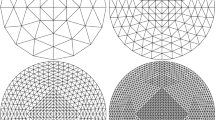Abstract
This paper introduces a novel three-field formulation for the Bingham flow problem and its two-dimensional version named after Mosolov together with low-order discretizations: a nonconforming for the classical formulation and a mixed finite element method for the three-field model. The two discretizations are equivalent and quasi-optimal in the sense that the \(H^1\) error of the primal variable is bounded by the error of the \(L^2\) best-approximation of the stress variable. This improves the predicted convergence rate by a log factor of the maximal mesh-size in comparison to the first-order conforming finite element method in a model scenario. Despite that numerical experiments lead to comparable results, the nonconforming scheme is proven to be quasi-optimal while this is not guaranteed for the conforming one.





Similar content being viewed by others
References
Arnold, D.N., Falk, R.S.: A uniformly accurate finite element method for the Reissner–Mindlin plate. SIAM J. Numer. Anal. 26(6), 1276–1290 (1989)
Brézis, H.: Monotonicity methods in Hilbert spaces and some applications to nonlinear partial differential equations. In: Zarantonello, E. (ed.) Contributions to Nonlinear Functional Analysis. Academic Press, New York (1971)
Carstensen, C., Gallistl, D., Schedensack, M.: Adaptive nonconforming Crouzeix–Raviart FEM for eigenvalue problems. Math. Comput. 84(293), 1061–1087 (2015)
Carstensen, C., Gedicke, J.: Guaranteed lower bounds for eigenvalues. Math. Comput. 83(290), 2605–2629 (2014)
Carstensen, C., Köhler, K., Peterseim, D., Schedensack, M.: Comparison results for the Stokes equations. Appl. Numer. Math. (2014). doi:10.1016/j.apnum.2013.12.005
Carstensen, C., Peterseim, D., Schedensack, M.: Comparison results of finite element methods for the Poisson model problem. SIAM J. Numer. Anal. 50(6), 2803–2823 (2012)
Carstensen, C., Schedensack, M.: Medius analysis and comparison results for first-order finite element methods in linear elasticity. IMA J. Numer. Anal. (2014). doi:10.1093/imanum/dru048
Crouzeix, M., Raviart, P.A.: Conforming and nonconforming finite element methods for solving the stationary Stokes equations. I. Rev. Française Autom. Inf. Recherche Opér. Sér. Rouge 7(R-3), 33–75 (1973)
Duvaut, G., Lions, J.L., Trémolières, R.: Inequalities in Mechanics and Physics. Springer, Berlin (1976)
Evans, L.C.: Graduate Studies in Mathematics. Partial differential equations, vol. 19, 2nd edn. American Mathematical Society, Providence (2010)
Falk, R., Mercier, B.: Error estimates for elasto-plastic problems. RAIRO Anal. Numér. 11(R–2), 135–144 (1977)
Fuchs, M., Seregin, G.: Variational methods for problems from plasticity theory and for generalized Newtonian fluids. In: Lecture Notes in Mathematics, vol. 1749. Springer, Berlin (2000)
Glowinski, R.: Sur l’approximation d’une inéquation variationnelle elliptique de type Bingham. RAIRO Anal. Numér. 10(R–3), 13–30 (1976)
Glowinski, R.: Scientific Computation. Numerical methods for nonlinear variational problems. Springer, Berlin (2008). (reprint of the 1984 original)
Glowinski, R., Lions, J.L., Trémolières, R.: Analyse numérique des inéquations variationnelles. Tome 1. Théorie générale premiéres applications. In: Méthodes Mathématiques de l’Informatique, vol. 5. Dunod, Paris (1976)
Mosolov, P.P., Miasnikov, V.P.: Variational methods in the theory of the fluidity of a viscous-plastic medium. J. Appl. Math. Mech. 29(3), 545–577 (1965)
Mosolov, P.P., Miasnikov, V.P.: On stagnant flow regions of a viscous-plastic medium in pipes. J. Appl. Math. Mech. 30(4), 841–854 (1966)
Mosolov, P.P., Miasnikov, V.P.: On qualitative singularities of the flow of a viscoplastic medium in pipes. J. Appl. Math. Mech. 31(3), 609–613 (1967)
Verfürth, R.: A review of a posteriori error estimation and adaptive mesh-refinement techniques. In: Advances in Numerical Mathematics. Wiley, Chichester (1996)
Acknowledgments
The third named author was supported by the Berlin Mathematical School.
Author information
Authors and Affiliations
Corresponding author
Rights and permissions
About this article
Cite this article
Carstensen, C., Reddy, B.D. & Schedensack, M. A natural nonconforming FEM for the Bingham flow problem is quasi-optimal. Numer. Math. 133, 37–66 (2016). https://doi.org/10.1007/s00211-015-0738-1
Received:
Revised:
Published:
Issue Date:
DOI: https://doi.org/10.1007/s00211-015-0738-1




